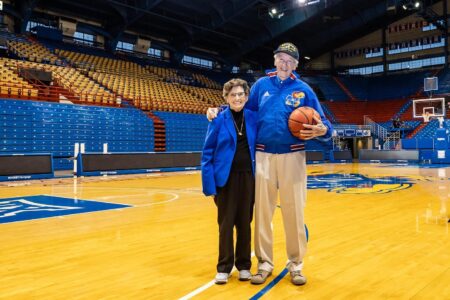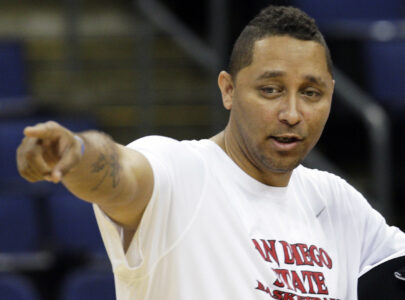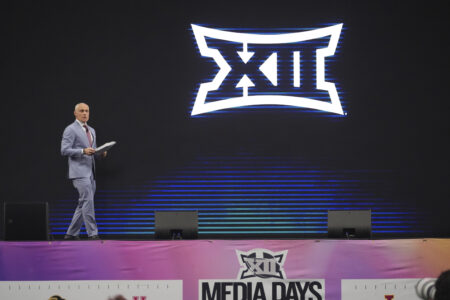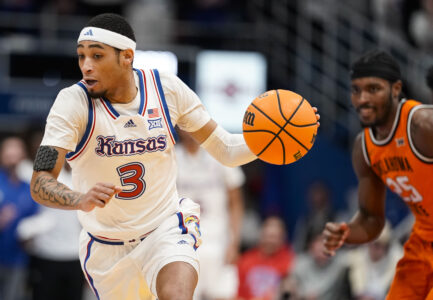Takeaways from the first draft of the KU men’s basketball roster

photo by: Nick Krug
Kansas head coach Bill Self gets at his players during the second half on Saturday, Nov. 16, 2024 at Allen Fieldhouse.
The Kansas men’s basketball roster, newly refreshed though it may be, will still almost certainly look quite different when the season tips off at Allen Fieldhouse on Nov. 3.
KU has made a habit in recent years of adding players as late as August, such as the likes of Johnny Furphy and David Coit, and head coach Bill Self has said he’s looking for another big man and a hot-shooting guard. KU’s recent activity in the international and transfer-portal markets, with former Northwestern Oklahoma State guard Camron McDowell recently on campus, suggests its staff is taking these searches seriously.
Even so, the recent update of the 2025-26 KU roster to include the 14 players currently on campus reveals a couple of key truths about next year’s team — while also prompting a couple more questions about how exactly the Jayhawks will make use of certain provisions of the recently approved House v. NCAA settlement.

photo by: AP Photo/Mike Stewart
Wagner guard Melvin Council Jr. (11) blocks a shot on North Carolina guard Elliot Cadeau (2) during the second half of a first-round college basketball game in that NCAA Tournament, Thursday, March 21, 2024, in Charlotte, N.C.
Good bones on defense
Self has, in brief comments about this season’s roster, talked about his team being “immensely more athletic.” Between that athleticism and the highly competitive personalities of players like Melvin Council Jr. and Darryn Peterson, this year’s Jayhawks should have the potential to be a quite stingy defensive team. If the roster is any indication, they’ll be a highly switchable one, too, with all 14 players currently listed between 6-foot-3 and 6-foot-10 — and the tallest, freshman Bryson Tiller, views himself as more of a forward than a center.
There are, of course, considerable downsides on offense in particular to lacking a dominant, imposing post presence like KU featured the last two years in the 7-foot-2 Hunter Dickinson. But Dickinson didn’t always have the quick feet required to help KU keep its shape against opposing ball-screen actions. Meanwhile, even as an extremely inexperienced freshman, back last Dec. 31 in KU’s conference opener against West Virginia, Flory Bidunga demonstrated he could switch onto guards if needed and keep pace.
This year’s team, even as its roster isn’t yet done by any means, is eminently more versatile on defense already.

photo by: AP Photo/Mark Humphrey
Vanderbilt guard Noah Shelby (2) reaches in on Morehead State’s Drew Thelwell, left, in the second half of an NCAA college basketball game Friday, Nov. 18, 2022, in Nashville, Tenn.
Who can or will be designated?
Noah Shelby, a onetime high-ranked guard who joined KU as a walk-on last season after playing for Vanderbilt and Rice, is still listed as an invited walk-on in his official team bio. There had been some thought earlier this year that he might go on scholarship during his second season with the Jayhawks, and of course that’s not out of the question until KU recruits its full complement of scholarship players.
However, with the new roster limits implemented by the recently approved House v. NCAA settlement, whether a player goes on scholarship or not is significantly less relevant. Instead of being limited to 13 scholarship athletes and throwing in a handful of walk-ons, college basketball programs can now feature 15 players, period, regardless of scholarship status — and for KU that number is just 14 for the 2025-26 campaign as it endures the final penalty from the Independent Accountability Resolution Process.
But as part of some late-in-the-game revisions to the settlement, schools are able to declare certain players as “designated student athletes” (DSAs) who, according to the College Sports Commission that oversees the enforcement of these new rules, were “removed or would have been removed from the school’s roster due to the implementation of roster limits.” These players will not actually count against the limits for the duration of their college careers.
It is up to a school’s discretion to appoint these players, according to the CSC, and the NCAA specified in a recently released question-and-answer document that a list of DSAs must be submitted by July 6 and cannot be revised later on.
Well, as it happens, KU currently features 14 total players on its roster with 10 apparently on scholarship and four walk-ons (including Shelby). With so many potential openings left at this juncture it will be interesting to see if KU still makes a case that all four “would have been removed” due to roster limits, in time for the July 6 deadline. And by the way, unless KU squeezes in four more scholarship players to fill every roster spot it may not be public knowledge who exactly gets labeled a DSA.
No Nickens yet
It is likely also worth noting in this context that two-sport athlete Jaden Nickens, an incoming freshman wide receiver for the KU football team who has said he chose to attend the school in part because he would also get the chance to play men’s basketball, is not currently listed on the basketball roster.
Football coach Lance Leipold has said Nickens would begin basketball activities upon the conclusion of the football season, so that could explain his current absence.
However, by the start of the season a multisport athlete must be listed on the official rosters for all teams on which they participate, according to the NCAA Q&A, and so KU will have to make a preseason decision about whether to include Nickens on the men’s basketball roster.
While the widespread consensus has always been that Nickens would count toward roster limits for both football and basketball, a DSA can be someone who was recruited “to be, or was assured by an institutional staff member the individual would be, on the institution’s roster for the 2025-26 academic year.” If KU can make a case that Nickens was at some point assured he would play basketball, couldn’t he also be a DSA for his entire basketball career?

Kansas guard Jamari McDowell and Kansas guard Elmarko Jackson have a laugh during a team practice on Wednesday, March 19, 2025 at Amica Mutual Pavilion in Providence, R.I. Photo by Nick Krug
New doesn’t mean inexperienced
For all the talk about how KU returns just one scholarship player who actually took the floor last season — that would be the center Bidunga, who averaged 5.9 points and 5.4 rebounds in 2024-25 and Self says “needs to take the biggest step” — it becomes a lot clearer when looking at the recently updated roster that the Jayhawks don’t have a particularly young roster when taken together.
Yes, the focal point of this year’s team is a freshman, Peterson, and the player he was most eager to team up with was Bidunga, a sophomore. Self has even called Tiller, now a redshirt freshman as he enrolled early in the winter, a future pro.
But the team’s early locker-room leaders, returnees Elmarko Jackson (who missed last year due to injury) and Jamari McDowell (who redshirted) are entering their third season in the program, and all three transfer additions to this point are seniors.
Council has played at three different steadily escalating levels of basketball entering his fifth season as a college player, Jayden Dawson has seen high-level and postseason play in the Atlantic 10 in three years at Loyola-Chicago, and Tre White is about to enter his fourth different power conference in four seasons.
Self has had some issues easing the adaptation process for veteran transfers in recent years, mentioning at times how they may have already developed habits of which it’s difficult to disabuse them.
But that’s where fit comes in. For better or worse, KU’s portal approach created “an appearance that we haven’t gotten as highly respected guys, nationally,” as Self said recently. He had been aiming to “recruit fits rather than talent,” he told The Athletic in May. That could allow these veteran additions to contribute right away at a level commensurate with their talent and experience, which most of last year’s transfer additions failed to do.







